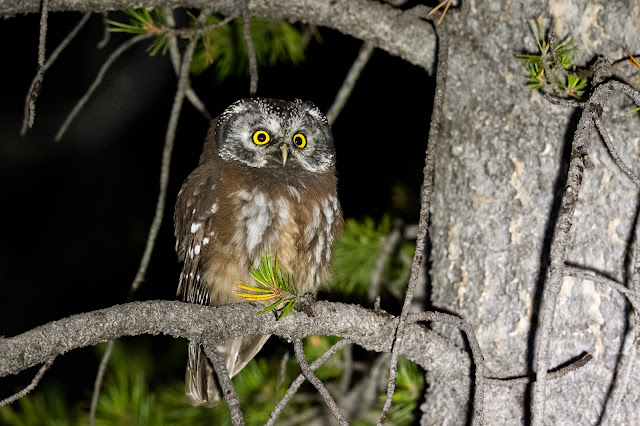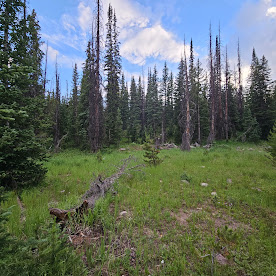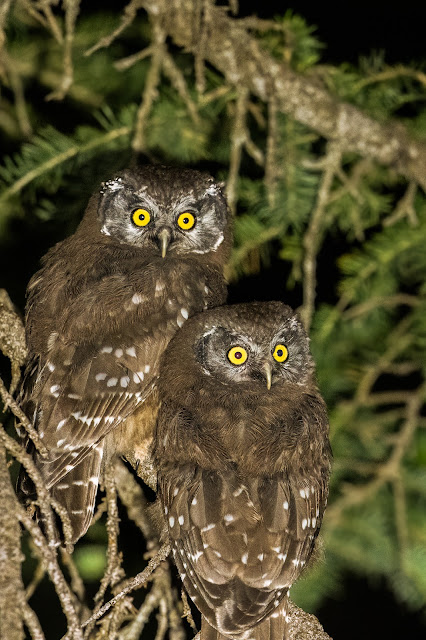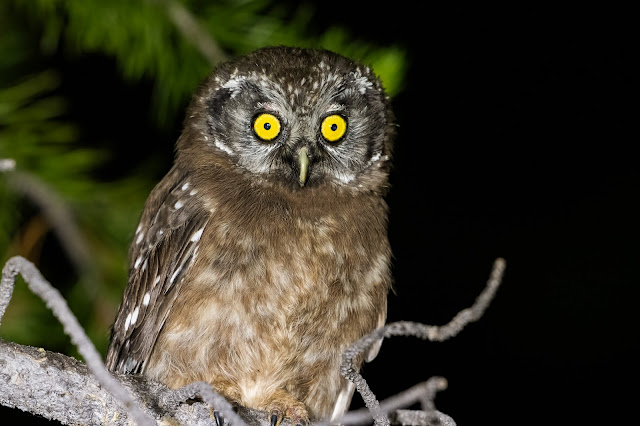 |
| Juvenile Boreal Owl Siblings Observed in the Uinta Mountains Wasatch County, Utah July 2024 |
Where do Boreal Owls breed in Utah's Uinta Mountains? How widely are they breeding? These and similar questions have puzzled and challenged Terry Reid, James Loveless, and me for several years. We've searched online to find information about the species in Utah, but it seems that very little research has been published with regard to the Utah populations of Boreal Owls. Most of the research we find online has been done to study populations in our neighboring states of Colorado, Wyoming, and Idaho. BirdsOfTheWorld.org includes a statement under the Breeding Range section for the species that "although there are no confirmed records, breeding is probable in the mountains of Utah." We have a friend who is an ornithologist who observed a nest over twenty years ago. We also know that our work over the past few years inspired a college student to conduct breeding bird research during this year's breeding season. We are eagerly awaiting his results.
Since we individually had our first Boreal Owl encounters in the Uinta Mountains (the Uintas) in late August and September of 2020, we have made repeated individual and joint trips to remote and rugged areas to learn as much as possible about the natural history of the species in the field. My friends and I are hobbyists, not ornithologists, but we've deliberately endeavored to contribute to science by adding data to the heretofore-thin body of knowledge for the species in Utah since 2020. We united our efforts in the fall of 2022 to execute a plan to document the wide-spread presence of the species by locating, photographing, and recording vocalizations of them in five distinct locations throughout the western end of the Uintas. The surprising results of those efforts were shared in a previous post at this link. Our discoveries, once made public by our eBird reports and NeoVista Birding and Wildlife blog posts, ignited interest in and attention on the species. Members of the local birding community as well as out-of-state visitors have "flocked" to where we made our original discoveries.
This post shares some of the results of a personal project we completed this summer to document as many juvenile Boreal Owls as possible in the western portion of the Uinta Mountains. The objectives were to document evidence that Boreal Owls breed in the Uinta Mountains and capture images of hatch-year birds at various stages of molt to help prove a theory that we have that many of the adult-looking birds that have been observed in small groups during previous fall months are actually hatch-year siblings that have molted into adult-like plumage and are still associating with one another. Based on our results for the western portion of the Uinta Mountains, we believe that the species is present and breeding throughout the Uinta Mountain range at the right elevations and in their preferred habitat. We would love to help biologists from the state of Utah study this species should that opportunity become available.
Our Approach to Gathering Breeding Data
The winter snowpack in the Uinta Mountains can reach as high as ten feet in some locations. Consequently, Mirror Lake Highway, the main access route to the western portion of the Uintas where my friends and I have focused our efforts, is closed from the first major snowstorm until typically sometime in late June. These circumstances make it logistically challenging to access high-elevation Boreal Owl breeding habitat during courtship, when male Boreal Owls are actively singing to draw mates to potential nest sites. Snowmobiles can be used to access breeding habitat via the main highway during winter, but they come with a level of risk in harsh and remote conditions. Rather than make the efforts to use snowmobiles to find males singing for mates at potential nest sites in February and March, my friends and I decided to look for and document recently-fledged juveniles during the summer months when we would have the ability to cover more breeding habitat safely in a shorter timeframe using our trucks.
When we began to figure out how to find Boreal Owls in the Uintas in the fall of 2020, we noticed that it was typical for us to locate multiple birds at a time. We theorized that those birds were members of family groups that were still interacting with siblings and possibly parents. It seemed reasonable to believe that hatch-year birds could have molted from their distinct juvenile plumages to adult-like plumage in the five to six months between hatching around mid-April and our annual observations of them in September and October. Our theory seemed worthy of testing when we studied molts for the species on the Birdsoftheworld.org website. In order to have evidence that the birds hatched in the Uintas and molted to adult-like plumage over a specific time period, my friends and I would need to get photos and audio recordings of them while they were showing juvenile, transitional, and adult-like plumages. The window for doing that would be from the time the roads open in late June through July and mid-August, before the hatch-year birds would start looking and vocalizing like adults.
We had half-heartedly tried finding juveniles a few times over several summers without success, so we puzzled over where they would nest and how far they would wander from nest sites over what period of time. Would nests be in mature aspen stands, old spruce-fir stands, or both? At what elevation? How could they possibly feed and raise families at elevations where the snowpack could be six, seven or ten feet deep? The questions were endless, but so was the determination to find answers. Consequently, we plotted several target areas and began an earnest search on July 11, 2024
Our Initial Juvenile Boreal Owl Discoveries
Fortune, planning, and determination combined the evening of July 11, 2024 when a streak of encountering fledglings and juveniles began for us. And, just to be clear, we chose different locations each time we went out to locate and document the presence of juveniles. We did not want to encounter the same birds on subsequent trips during the season. Thus, our impact on the individual birds would be minimized.
We decided to begin our summer search in a spot that I had checked unsuccessfully three years earlier. I was playing a Boreal Owl recording from my phone when I heard the faint begging call of a juvenile Boreal Owl. It was the first time hearing the begging call from a live bird, so I felt a rush of excitement. I alerted my friends to tune in to the sound. We faced the direction of the begging bird with our hands cupped behind our ears as if we were parabolic receivers. There was no wind at that time, so we were able to hear a sound that rose ever so slightly above the silence surrounding us. Wow! The excitement! And then there were two birds broadcasting their begging calls in response to my playback. We followed the call of one bird deeper into the forest and got our first visual observation of a juvenile Boreal Owl in the Uinta Mountains. The bird didn't sit still for long, but we managed to capture some images along with recordings of the begging calls to document the encounter. The perceived look of curiosity in the eyes of that bird left an indelible image in my mind's eye. It was already showing some plumage traits of an adult bird. White feathers were beginning to overtake the chocolate-colored face of a juvenile and the sooty underside was giving way to the light and dark spotting and streaking of an adult. I could imagine at that time how continued molting over the next six to eight weeks would have that bird looking more like an adult than a juvenile. In other words, it would look like the numerous birds we had observed in September and October in previous years. It's not a high-quality image, but the following image memorializes our first observation of a juvenile Boreal Owl in the Uinta Mountains.
 |
| Juvenile Boreal Owl observed in the Uinta Mountains, Wasatch County, Utah July 2024 |
 |
| Juvenile Boreal Owl, Wasatch County, Utah July 2024 |
 |
| Juvenile Boreal Owl, Wasatch County, Utah July 2024 |
At one point during our observation of the second group of juveniles we heard an adult respond to the begging call of one of the juveniles. That interaction is captured in the following audio clip.
Our Third Family Group (July 17, 2024)
We made our way to a different location of the Uintas six days after our first juvenile encounter. We planned this trip using the knowledge we gained from our previous encounter. Our target area was still in Wasatch County, but it was miles from the previous week's encounter. Remarkably, we located a group of five juveniles shortly after sunset. We were able to observe two birds on a single branch while hearing three others beg from distinct locations.
 |
| Juvenile Boreal Owl in the Uinta Mountains, Wasatch County, Utah July 2024 |
Juvenile Boreal Owl in the Uinta Mountains, Wasatch County, Utah July 2024 |
|
Three separate juveniles can be heard begging in the following audio file.
We never saw nor heard an adult while observing this group, but we suspect that they were nearby.
Our Fourth Group of Juveniles (July 18, 2024)
We found our fourth group of juvenile Boreal Owls of the season the next evening when we targeted a location in Duchesne (doo-shayn) County. This encounter confirmed three juveniles and one adult. We observed two of the juveniles while hearing at least one other bird begging nearby. The adult and one of the juveniles cooperated fairly well for a few photos.
 |
| Boreal Owl Parent Observed With Three Juveniles in Duchesne County, Utah July 2024 |
 |
| One of Three Juvenile Boreal Owls Observed in Duchesne County, Utah July 2024 |
The Fifth Group of Juveniles (August 1, 2024)
I made an impromptu solo trip to a Summit County location the evening of August 1st to see if I could confirm the presence of juvenile Boreal Owls for our third county of the season. I know that county lines are human constructs that matter not to birds, but the purpose was to help show that breeding Boreal Owls were widespread, not just in isolated pockets. I had to work a little harder that evening. A new route that I tried to use to get to my target location resulted in a dead end and a single juvenile Northern Saw-whet Owl. I backtracked from that route and made my way using a more familiar route to the target location. I arrived at the general location after 11 PM under a moonless but clear, starlit sky. The wind was calm and the temperature was dropping from sixty to the high fifties Fahrenheit.
I had an adult respond with a single "kip" call at my first stop. I listened for the begging calls of juveniles for a little while with no success. A little farther up the mountain was a place that just felt right, so I spent some time there soliciting responses. I was surprised to have a couple of Long-eared Owls hover above and around me at an elevation of nearly 9600' in response to my Boreal Owl playback. There were at least two Long-eared Owls that entertained me for a few minutes as they responded to my playbacks. I was surprised to see the species at that elevation, so that became a new data point for Long-eared Owls in Utah. I was not able to get an accurate count because the owls were flying in and out of the forest, but I did see two at once. A moment later, as if they had no concern for what I thought would be predator owls flying in their vicinity, I heard an alarm call from an adult Boreal Owl which seemed to prompt a trio of juveniles to simultaneously start begging. The adult flew into a tree right next to me after I walked farther into the woods, but it flew just after I illuminated it and before I could photograph it. One of the three juveniles came in close and begged from the opposite side of a dead conifer that I was facing. That moment allowed me to capture the following recording of its repeated begs.
I was unable to get photos of the one juvenile that I eventually saw because it was adept at flying and never stayed at one perch long enough for me to get a photo. I didn't want to repeatedly bump it from its perches for the sake of a photo.
When I realized that it was 12:36 AM, I decide to call it quits. I had a rocky two-mile stretch and then a ninety-minute drive ahead of me with work appointments starting early in the morning. As I finished the roughest four miles of road that I've ever driven for Boreal Owls, I asked myself, "Who does this by themselves in such remote and rugged areas at 1 AM, with no cell coverage and miles from the nearest asphalt?" My Tacoma TRD Off Road did its job well that night. Below are a couple of images showing what is sometimes a typical road to traverse in order to get to elevations between 9000' and 10000' for Boreal Owl habitat in the Uinta Mountains.
 |
 |
| One of the "Fun" Miles-long Roads to Boreal Owl Habitat in Utah's Uinta Mountains Elevation nearly 10,000' |
Our Sixth, Seventh, and Eighth Groups of Juveniles (August 5, 2024)
Once we clued into a few things with our first juvenile encounter, we were able to have success on each subsequent trip we made. That streak continued when we ventured to a new area that James had scouted successfully over a week earlier. On the evening of August 5th, we located three separate family groups. We worked a little harder than usual for the first group as we trekked through a dark meadow, riddled with trip hazards, and deeper into dense woods shrouded in darkness. We had so much fun navigating our way through the meadow and thick woods to locate the birds that we became a little disoriented when it came time to emerge from the euphoric encounter and return to the truck. We knew we'd be fine, but it's moments like that that cause some people who are unfamiliar with the Uinta wilderness to end up as news stories. Once we were back in the truck, Terry told me that I was like a coonhound on a scent to track down that group of owls. He teased that my role was to get the birds to come to us rather than have him follow me through the hazardous terrain and dense forests to find them. My response? Well, sometimes the difference between seeing and not seeing the target is in "the going after". We often have fun razzing one another. I've been told more than once that I was not doing my job after standing around in a dark wilderness in the wee hours of the night with no bird to show for it. But, truth be told, we all know that a journey into the wild with friends is a blessing on its own.
We saw at least one adult and one juvenile with that first encounter of the night. Two other juveniles were heard begging from separate locations. The plumage of the juvenile we observed had molted to an adult-like facial disc, white spotting on the forehead, some larger white spotting on the back, and dark streaking and white spotting on underside.
I was handholding the lens at 600mm when I captured the following video, so it was hard to hold the lens steady, but here is a short video of the first juvenile of the evening.
 |
| One Parent of Several Juvenile Boreal Owls in Wasatch County Utah, August 2024 |
 |
| One Parent of Several Juvenile Boreal Owls, Wasatch County Utah, August 2024 |
 |
| One of Several Juvenile Boreal Owls Found in Wasatch County, Utah in August 2024 The facial disc and underside are showing plumage traits of an adult bird. |
 |
| One of Several Juvenile Boreal Owls Found in Wasatch County, Utah in August 2024 The facial disc and underside are showing plumage traits of an adult bird. |
Surprisingly, we had a juvenile Northern Saw-whet Owl fly into the tree next to the juvenile Boreal Owl we were observing. The Saw-whet didn't stay in that tree for long, but it perched in a nearby tree long enough to allow some images.
 |
| Juvenile Northern Saw-whet Owl in Wasatch County, Utah in August 2024 |
The second group we located was distant, but we could hear at least two juveniles begging. We chose not to track down another distant group on foot and drove to other locations where we eventually found our third group of the evening. We heard two begging juveniles that were not far from our location, but we focused our attention on the one closest to us. That juvenile was also starting to look more like an adult, so we began to wonder about how many months old the typical juvenile would be when it ceased using the begging call and introduced songs and other calls into its vocal repertoire. So far, none of the juveniles that we'd heard made any vocalization other than the begging call. We suspect that they will transition from begging calls to adult vocalizations between now and mid-September because that is when our searches in previous years have tuned up only adult-like birds making adult-like vocalizations.
 |
| Juvenile Boreal Owl, Wasatch County, Utah August 2024 This molting hatch-year bird is showing an adult-like facial disc and some of the dark streaking and white spotting of an adult on the chest. |
Wrapping Up the 2024 Search for Juvenile Boreal Owls
 |
| Juvenile Boreal Owl, Wasatch County, Utah in August 2024 This molting hatch-year bird is looking more like an adult than a juvenile at this point. |
 |
| Juvenile Boreal Owl, Wasatch County, Utah in August 2024 This molting hatch-year bird is looking more like an adult than a juvenile at this point. |
 |
| Juvenile Boreal Owl, Wasatch County, Utah in August 2024 This molting hatch-year bird is looking more like an adult than a juvenile at this point. |
 |
| Juvenile Boreal Owl, Wasatch County, Utah in August 2024 This molting hatch-year bird is looking more like an adult than a juvenile at this point. |
 |
| Hatch-year Boreal Owl that has molted into adult-like plumage except for tawny juvenile feathers that remain in the belly of the bird. Wasatch County, Utah (August 26, 2024) |
 |
| Hatch-year Boreal Owl Looking Very Adult-like in Wasatch County, Utah (August 16, 2024) Some tawny juvenile feathers still remain in the chest and belly areas of the bird. |
 |
| Hatch-year Boreal Owl that has molted into adult-like plumage except for tawny juvenile feathers that remain in the belly of the bird. Wasatch County, Utah (August 26, 2024) |













